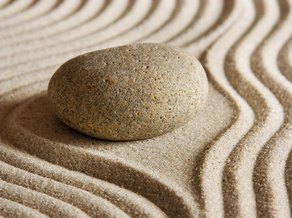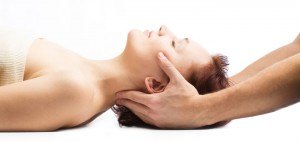What is Craniosacral Therapy?
An American Osteopath, William Garner Sutherland (1873–1954) brought craniosacral work to the w orld in the 1930’s. His work focused on the 22 bones of the skull, the
orld in the 1930’s. His work focused on the 22 bones of the skull, the
sacrum, vertebral column, the membranes of the central nervous system, the brain, spinal cord and cerebrospinal fluid. He noticed that when the body was in balance that these bones, membranes and fluids exhibited a rhythmical movement pattern much like gentle waves in the ocean. He also noticed that trauma or injury to the body can cause this wave-like motion to display a disrupted pattern. This wave can be detected by human hands and allowed to be skillfully brought back into balance with gentle touch. During the process of re-balancing, as occurs during a Craniosacral session, the body/mind of both client and practitioner come to a quiet stillness that is noticed as a native state in which the body/mind/heart is able to heal. The inherent feeling of wholeness becomes apparent as an always present possibility waiting for us to abide within it again. It literally feels like the body/mind is going back in time prior to the injury or trauma and reminding the cells and tissues of their greater potential. This may or may not be the felt sense of the client but the feeling of calm and relief of tension is clearly experienced. After the session, clarity of mind, spaciousness of body, healing and reduction of tension is often experienced.
What are the benefits of Craniosacral Therapy?
 Everyone can benefit from Craniosacral Work. All of us have occasional aches and pains or times of feeling out of balance. Because this system of healing reorients us toward our potential in health, past injuries or traumas (even forgotten ones) may be resolved with no need to relive them. Craniosacral Work is a whole body wellness modality and there is no need for something to be wrong to benefit from the session. Since Craniosacral work is very balancing, it is a great preventative modality. Craniosacral work has been helpful for the following:
Everyone can benefit from Craniosacral Work. All of us have occasional aches and pains or times of feeling out of balance. Because this system of healing reorients us toward our potential in health, past injuries or traumas (even forgotten ones) may be resolved with no need to relive them. Craniosacral Work is a whole body wellness modality and there is no need for something to be wrong to benefit from the session. Since Craniosacral work is very balancing, it is a great preventative modality. Craniosacral work has been helpful for the following:
- TMJ Disorder
- Whiplash
- chronic neck and back pain
- eye strain
- headaches
- symptoms of stress
- chronic fatique syndrome
- fibromyalgia
- irritable bowel syndrome
- spinal cord injuries
- ankylosing spondylitis
- brain injury
- autism
- sinusitis
- difficulty concentrating
- ADHD
- dyslexia
- dizziness
- scoliosis
- muscle tension
What is special about Craniosacral Therapy?
Craniosacral Therapists learn anatomy of the skull, brain and spine, and the mechanics of movement of these parts and how they interrelate with each other and the rest of the body. They learn how to detect the wave-like motions and their possible incongruities with an extremely gentle touch. This touch may also be used to allow these incongruities to righten themselves. Because of the quiet nature of the work, many therapists become acquainted with the energetics of the bones and nervous system. The bones themselves produce a piezolelectric charge and the nervous system has a close association with Chi or Prana or the energy of health. These energies “dance” with the cranial wave and when one is balanced the other is balanced. It is understood that when our energy is balanced our health is balanced.
In Visionary Craniosacral Work the heart is opened to listen to the subtle energies so that the practitioner is able to ask where and how the body needs to be touched for optimal healing. Touch is guided by the wisdom of the client’s energy, which is moving back to health. In Biodynamic Craniosacral Work, more subtle and slower wave patterns that become more apparent as the body/mind comes to a place of calm are followed by the practitioner. When this occurs the work is less mechanical and the waves felt are more whole-body; like a gentle breeze. William Sutherland called this breeze the “Breath of Life”. Here we can be in touch with what reorients us back to health and to our greatest potential.
Who gets Craniosacral Therapy?
People of all ages and walks of life come to receive Craniosacral work. Many of my clients have been referred to me by dentists, massage therapists, physicians, social workers and chiropractors.
What should I expect after each session?
You may find a great desire to relax and be in a quiet environment for some time afterwards. Craniosacral sessions are very helpful in allowing the body to rest in the parasympathic nervous system response, which is the part of our nervous system that triggers relaxation and healing. I would not recommend scheduling an appointment prior to a loud or highly energtic event, such as a football game or concert. I find that craniosacral session help to clear my mind and bring focus to what I need to feel well and whole. I often take a walk on the beach after a session to continue my connected feeling to fluid motion and energy. I also enjoy a hot sea salt bath.
How frequently can I schedule sessions?
This varies from person to person. People have come as often as twice a week, but usually they come once each week. Some space the session apart and come every other week or once each month.
